SHRP2 Milestones
SHRP2 Milestones highlights significant project developments, case studies, best practices, and what is trending in SHRP2 from across the Nation.
Issue 5: November 2016 SHRP2 Milestones News Brief
Issue 4: SHRP2 Education Issue, May 2016
Issue 3: Round 7 Implementation Assistance Program, Round 7 Issue March 2016
Issue 2: December 2015 SHRP2 Milestones News Brief
Issue 1: August 2015 SHRP2 Milestones News Brief
-
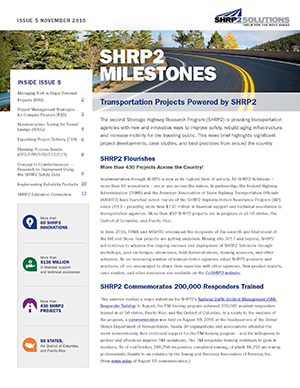
Transportation Projects Powered by SHRP2
SHRP2 Program: Moving SHRP2 Solutions into mainstream transportation practice.Universities Employ Innovative Approaches Integrating SHRP2 into Classroom StudiesBuoyed by the response from the first offering of the SHRP2 Education Connection, the FHWA’s application review team got down to work to narrow the field and select the 10 universities that would receive grants. The team looked for those universities that presented the best scenarios for incorporating SHRP2 technologies into their curricula, and that could do so in a timely manner. The applications were impressive – covering a wide range of SHRP2 products and teaching approaches. Each institution employed a unique method to integrate and teach the SHRP2 subject matter to their students. Most taught the new material in the 2015 fall semester; others are in the process of exposing students to SHRP2 in the current (2016 spring) semester.
The stories of four of the universities are featured in this issue. These highlights provide a good glimpse into the variety of innovative teaching approaches the recipients employed. The FHWA is extremely proud of the work of all 10 of the universities selected, and appreciates their efforts to bring SHRP2 Solutions into the classroom. Read more
SHRP2 Moving Us ForwardComing in January 2016, a new report, SHRP2 Moving Us Forward will highlight SHRP2 implementation activities and progress over the past three years. The American Association of State and Highway Transportation Officials (AASHTO) and the Federal Highway Administration (FHWA) share a goal of making SHRP2 Solutions available to as many transportation professionals as possible—knowing that the extensive research would reap important innovations that could change the way transportation agencies approach familiar challenges. In 2013, AASHTO and the FHWA launched the SHRP2 Implementation Assistance Program (IAP) to deploy SHRP2 Solutions in real-world situations. Read the full story in SHRP2 Milestones Issue 2.
Universities Incorporate SHRP2 Solutions Into Transportation Curriculum
In April 2015, the FHWA accepted applications from universities interested in incorporating SHRP2 Solutions into their curricula. The application process resulted in 10 universities becoming recipients of an estimated total $100,000 in cooperative agreements under the SHRP2 Education Connection initiative. Over the subsequent months, lesson plans, case studies, or other learning opportunities that integrate SHRP2 Solutions into their curricula were developed for both undergraduate and graduate courses covering a broad spectrum of products from the Renewal, Capacity, and Reliability focus areas. Read the full story in SHRP2 Milestones Issue 2.
SHRP2 IMPLEMENTATION ASSISTANCE PROGRAM
Established in 2013, the SHRP2 Implementation Assistance Program (IAP) offers transportation agencies financial and technical assistance in deploying SHRP2 Solutions. To date, six IAP rounds have been offered spurring deployment of dozens of SHRP2 innovations through more than 300 projects across the country. The IAP will conclude with a seventh and final round’s launch on April 1, 2016.
CAPACITY: Bringing greater collaboration to road building.State DOTS Identify Strategies to Expedite Project Delivery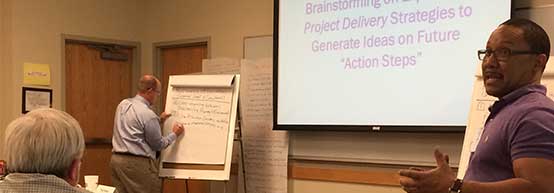
Six state DOTs identified constraints associated with their project development and delivery processes and practices — and defined strategies for addressing them using the SHRP2 Solution, Expediting Project Delivery (C19). Navigating the transportation planning and project development processes can be time consuming and costly. Elected officials and the public expect transportation projects to be developed and delivered with fewer delays, greater transparency and collaboration, and in ways that address environmental challenges. Expediting Project Delivery identifies strategies to speed the development and delivery of transportation projects, balanced with environmental and resource issues. Read the full story in SHRP2 Milestones Issue 2.
North Carolina: Freight Demand Modeling Offers Roadmap to 2020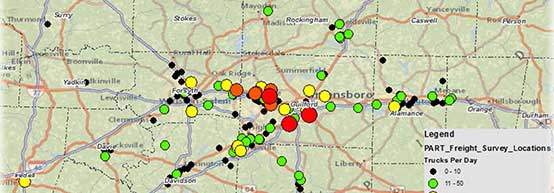
Major industries in the Piedmont Triad region of North Carolina, one of the world’s largest transportation and logistics clusters, have shifted from the textile industry to the freight and logistics industry. This cluster originally emerged from serving the manufacturing sector, but has continued to grow through diversification into Transportation and Warehousing and Retail Trade. This growth is not surprising given the confluence of I-85 and I-40 and the connectivity they provide to major logistic centers like Atlanta and the Boston-New York-Washington Mega-Region. This shift in industry focus coupled with the Piedmont region’s proximity to major logistic centers has emphasized the need for efficient movement of freight. The area’s existing travel demand model, the Piedmont Triad Regional Model (PTRM), was not describing freight flows in the region sufficiently to meet that need. Read the full story in SHRP2 Milestones Issue 2.
Cutting-edge Planning and Analysis Tools are Just 1 Click Away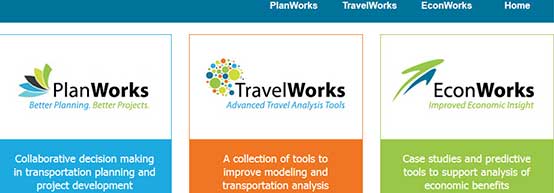
With one click, the SHRP2 planning tools website provides transportation professionals with three key planning and analysis tools: PlanWorks (C01), TravelWorks (C16), and EconWorks (C03 and C11). These tools – which originated from SHRP2 Capacity focus area research – will help transportation planners create better collaborative processes; produce better modeling and transportation analysis; and introduce economic benefit analysis into early project decision making. Read the full story in SHRP2 Milestones Issue 2.
PlanWorks Promotes Collaborative Decision Making in Transportation Planning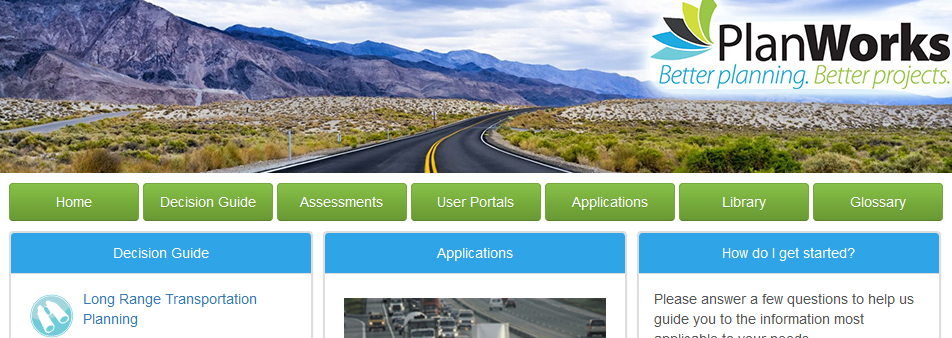
Launched in May 2015, PlanWorks (C01) is a Web resource that supports collaborative decisionmaking in transportation planning and project development. PlanWorks is built around key decision points in long-range planning, programming, corridor planning, and environmental review. PlanWorks suggests when and how to engage cross-disciplinary partners and stakeholder groups. This system can help build consensus throughout these processes. Transportation agencies are encouraged to visit PlanWorks.
Resources
On-Call Team Offers Technical Assistance for Agencies Implementing Eco-Logical
SHRP2 has developed an Integrated Ecological Framework (IEF), a nine-step, science-based process that helps practitioners identify ecological priorities within a region and make timely decisions about highway enhancements. Through SHRP2 implementation, 14 State departments of transportation (DOT) and Metropolitan Planning Organizations (MPOs) received assistance to advance implementation of the Eco-Logical approach in their agencies. An On-Call Technical Assistance Team is available to provide responsive, individualized guidance and support to State DOTs, MPOs, resource and regulatory agencies as they implement the Eco-Logical approach. This effort is in support of the implementation plan for the SHRP2 Solution, Implementing Eco-Logical (C06). The Team can assist with organizational, technological, regulatory, or scientific issues. An increasing number of agencies are requesting and receiving technical assistance.
Resources
RENEWAL: Enabling faster, minimally disruptive, and longer-lasting improvements.Rhode Island: Project Management Strategies for Complex Projects
It’s an unwritten, paradoxical law: the more stakeholders, the more complex the project; and the more complex the project, the more stakeholders there are. In addition to the extra stakeholder scrutiny, complex projects also involve financing challenges beyond the traditional technical, cost and schedule complexities. Find out how Rhode Island DOT (RIDOT) is meeting these challenges in a new SHRP2 case study. Read the full story in SHRP2 Milestones Issue 2.
Precast Concrete Pavement Used in a Variety of Applications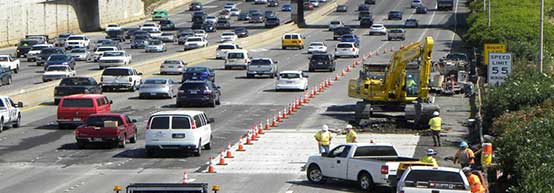
Precast Concrete Pavement (PCP) (R05) is being implemented in many ways by highway agencies throughout the United States to reduce the duration of lane closures during construction, improve work-zone safety, and provide long-lasting pavement performance:
- • Alabama, Pennsylvania, and Kansas: Rehabilitating traffic intersections
- • Hawaii: Replacing concrete pavement
- • Illinois Tollway: Replacement of bridge approaches
Read the full story in SHRP2 Milestones Issue 2.
Kentucky Implements New, Smarter Software to Manage Utility Conflicts
Annually, $65 million is spent in Kentucky for utility relocations associated with highway, interchange, bridge replacement, and road widening projects. As a result, the Kentucky Transportation Cabinet (KYTC) is working to streamline and create standard procedures for its designers and utility experts, while minimizing utility conflicts. Although the KYTC has worked effectively with its utility companies in the past, SHRP2 opened the door to an opportunity to improve this coordination. By incorporating new methodologies developed through the SHRP2 Solution, Identifying and Managing Utility Conflicts (R15B), the agency is enhancing and upgrading its current tracking database while offering training to all potential users. The KYTC created the Kentucky Utilities and Rail Tracking System (KURTS). This database houses 340 active projects and is used by four utility companies and the 12 district offices in the State. With KURTS Release 2, the KYTC has offered to work with other States to share its experience to help minimize the costs of utility conflicts. Kentucky’s SHRP2 implementation activities have led to the development of new, "smarter" software that may be applicable to other States. Read the SHRP2 Case Study Managing Utilities in Kentucky.
Resources
SHRP2 Implementation Assists Rapid Replacement of 13 Bridges in 8 States
Innovative Bridge Designs for Rapid Renewal (R04) is a design toolkit for prefabricated bridge projects that allows agencies to streamline activities required to get bridge replacement systems designed, fabricated, and erected. Beginning in early 2014, this SHRP2 Solution has been employed in the replacement of 13 bridges in 8 States that experienced significant reductions in construction and/or road closure times.
Learn more about these and other bridge projects “In the Field” for Innovative Bridge Designs for Rapid Renewal.
- Arizona — Completed February 2015, Gila River Indian Community DOT applied the toolkit to the IR7 Gila River Bridge slide-in bridge project. Road closure reduced from an estimated 4-6 months to 11 days. [video]
- California — Completed September 2015, Caltrans applied the toolkit to Fort Goff Creek Bridge Prefabricated Bridge Elements and Systems (PBES) construction. [presentation]
- Kentucky — Completed December 2014, the KY-6 Stewarts Creek and Lynn Camp Bridges PBES projects required the road to be closed for less than 3 weeks. [video]
- Maine — Completed September 2014, the Kittery Overpass PBES project required only 29 days to finish.
- Michigan — Completed in April 2015, Federal Lands Highway applied the toolkit to Seney National Wildlife Refuge PBES project.
- Missouri — Completed in August 2014, the DOT applied the toolkit to Bridge A-0087 on Route B over Loop 70 in Columbia, MO. [video]
- Rhode Island — Completed in November 2014, the Warren Avenue PBES project required only a 21-day road closure. [video]
- Wisconsin — The Wisconsin DOT is applying the toolkit to five bridges and has already saved about 3 weeks of construction time on the first bridge project.
Resources
RELIABILITY: Championing predictable travel times.45 projects +1 Web site = Many Benefits to Transportation Research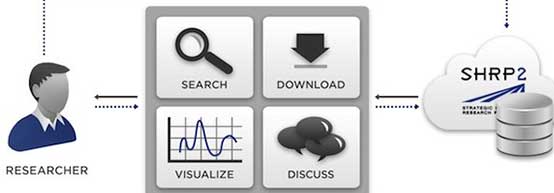
The research community, traffic engineers, planners, data managers, and others interested in data related to transportation operations and travel time reliability have an exciting new resource at their disposal. This resource — SHRP2archive.org — is a major accomplishment for the shrp2 reliability focus area and is expected to provide significant benefits for users involved with transportation research or policy projects. Read the full story inSHRP2 Milestones Issue 2.
Equipping Agencies and Practitioners for TSM&O
With tighter budgets, growing demands to move people and goods, and new operations data and strategies available, many State DOTs are increasing their emphasis on effectively managing and operating their existing facilities. To do this, some DOTs are elevating the role of transportation systems management and operations (TSM&O) by restructuring their organization, reworking their business processes, and working to change their culture. Read the full story inSHRP2 Milestones Issue 2.
SHRP2 TIM Responder Training Steadily Progressing on “March to the Million”
The end goal for the National Traffic Incident Management (TIM) Responder Training Program (L12/ L32A/L32B) is to train all 1 million emergency responders in the United States over the next decade. This initiative, called the “March to the Million,” has crossed the threshold of 120,000 trained in 2015, and is aggressively pushing forward on the quest to train responders for safer, faster, and more integrated incident response. In addition to the more than 4,500 in-person sessions that have been conducted, a 4-hour no-cost Web-based training course was launched in October 2014 and is available through the National Highway Institute. To ensure this valuable training program becomes institutionalized for future generations of emergency responders, outreach efforts already have engaged approximately a dozen public safety academies to adopt the 4-hour version of the TIM course as a training requirement for their new recruits. The National TIM Responder Training Program is also an Every Day Counts 2 innovation.
Resources
- National Traffic Incident Management (TIM) Responder Training Program (L12) product page
- Web-based Training
- Communications Toolkit
- TIM Training Newsletter
- TIM Training State Point of Contact List
- National TIM Responder Training (video)
- National TIM Responder Training Success Stories in the Innovator
Organizing for Reliability: Self-assessments from 40 Workshops Reveal Valuable Best Practices
Organizing for Reliability Tools (L01/L06) is fostering more reliable travel times by helping transportation agencies advance their business and organizational capabilities for operations. With funding and capacity constraints, many agencies are looking to operations solutions to help them get the most they can out of their existing facilities. As a result there was great interest in the Organizing for Reliability products and 27 projects received SHRP2 implementation assistance awards in 2013. With these sites, earlier pilot sites, and some new sites, 40 State and regional self-assessment workshops have been conducted using the L06 Capability Maturity Model (CMM) to help agencies identify their strengths and weaknesses along six key dimensions of transportation systems management and operations (TSM&O) and develop action plans tailored to improve their capabilities. For example, many States have begun development of a TSM&O Program Plan for their agencies.
Similar in concept to the Strategic Highway Safety Plan (SHSP), the vision of these plans is to align TSM&O with the agencies’ goals, objectives, and resources to improve mobility and reliability of their system. As part of its implementation effort, Ohio DOT (ODOT) recently did a series of benchmarking scan trips to eight States. From these trips, ODOT gained valuable insight to best practices from other States that would help guide the agency to strategically incorporate TSM&O into its mission.
To more broadly share the results from these 40 workshops, a series of Webinars and whitepapers were developed to provide for each of the six capability dimensions. These Webinars, held from July through October 2015, are being offered to raise awareness of national trends and best practices that will help agencies understand the value of the growing discipline of TSM&O.
Resources
- Organizing for Reliability Tools (L01/L06) product page
- CMM Whitepapers
- CMM Dimensions Webinar Series 3: Performance Measurement – 8/27
- CMM Dimensions Webinar Series 4: Collaboration – 9/8
- CMM Dimensions Webinar Series 5: Systems and Technology – 9/24
- CMM Dimensions Webinar Series 6: Business Processes – 10/7
SHRP2 Helps Spawn National Operations Center of Excellence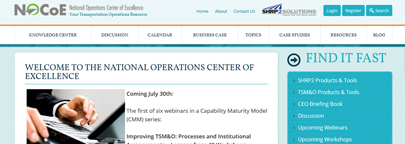
Building from SHRP2’s Framework for Improving Travel-Time Reliability (L17), an enhanced knowledge transfer system was developed that became the Web site for a new National Operations Center of Excellence (NOCoE). Launched in January 2015, the NOCoE is designed to provide the TSM&O community with knowledge and tools to fulfill their mission to enhance safety and reduce congestion. The NOCoE’s Web site contains a library of TSM&O resources, including SHRP2 products. Since its launch, the NOCoE has conducted two peer exchanges, hosted four Webinars and a virtual peer exchange, and added numerous new TSM&O resources. The NOCoE is hosting the Webinar series on the findings from the SHRP2 Organizing for Reliability workshops.
Resources
SAFETY: Identifying the behaviors that cause and avert collisions.Safety Training Analysis Center Promotes Use of SHRP2 Data
The Safety Training Analysis Center (STAC) at the FHWA Turner Fairbank Highway Research Center (TFHRC) was established to expand understanding of the SHRP2 Safety Data, which includes the Naturalistic Driving Study (NDS) and Roadway Information Database (RID). The STAC has three major goals:
- • Increase access to the data.
- • Improve the usability of the data.
- • Expand the number of users.
Read the full story in SHRP2 Milestones Issue 2.
Phase 1 Implementation: State DOTs Using SHRP2 Databases to Research 11 Safety Topics
Highway safety is a top priority for transportation agencies, as demonstrated by the impressive number of applications received for the Safety offering in Round 4 of the Implementation Assistance Program.
In August 2014, 10 States were awarded a total of $1.1 million in financial and technical assistance to conduct Phase 1 research on 11 safety topics using the SHRP2 Safety Data: the Naturalistic Driving Study (NDS) and the Roadway Information Database (RID).
The State DOTs selected to participate in Phase 1 using sample NDS data sets include Florida, Iowa, Michigan, Minnesota, Nevada, New York, North Carolina, Utah, Washington, and Wyoming; as part of Phase 1 they are to complete Proof of Concept research on pedestrian-vehicle interaction, roadway departures, speeding, work zones, horizontal and vertical roadway curves, interchange ramps, adverse weather conditions, and roadway lighting. The results from Phase 1 will be presented to the American Association of State Highway and Transportation Officials (AASHTO) Safety Task Force in October 2015, when it will be decided which of these studies will advance to Phase 2, the full research study using the NDS and RID data sets.
Safety Training and Analysis Center Assists Researchers in Using SHRP2 Safety Data
The recently established Safety Training and Analysis Center (STAC) at the Turner-Fairbank Highway Research Center (TFHRC) is continuing to make progress on accomplishing its goals to expand understanding of the Naturalistic Driving Study and Roadway Information Database; expand access to these data; expand usability of these data; and expand user base. The STAC in collaboration with the National Highway Institute, is currently developing training for DOTs and researchers that will familiarize them with the data and how it can be used to address safety and other transportation issues. The STAC will soon begin pilot testing secure data access at TFHRC and developing data analysis tools and reduced data sets. The STAC is already providing research opportunities through Fellowships and Sabbaticals, with additional researchers expected in the fall.
Resources
Featured Success Story
Powered by SHRP2
Powered by SHRP2: Vermont Fast Tracks Cultural Change and Bridge Replacement
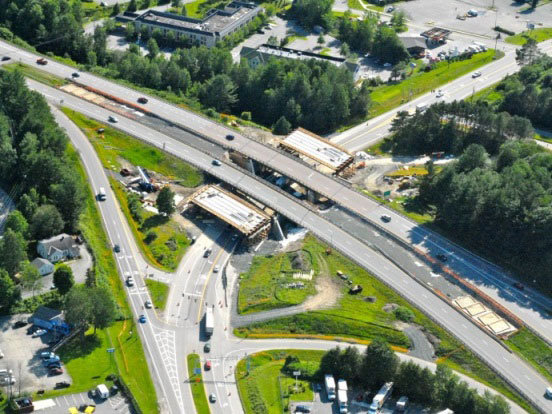
From coast to coast, transportation agencies strive to find ways to complete projects faster. The SHRP2 Solution, Expediting Project Delivery (C19), provides 24 strategies for addressing or avoiding 16 common constraints, which may hinder transportation planning and project development. The Vermont Agency of Transportation (VTrans) demonstrates the benefits of this SHRP2 product, as applied to the agency’s accelerated bridge program.
Using lessons learned from Tropical Storm Irene in 2011 and endorsement from the highest levels within VTrans — the agency set a goal to drastically cut project development times from 60 months down to just 24 months. In August 2013, VTrans saw an opportunity to become a lead adopter of the SHRP2 product, Expediting Project Delivery in Round 2 of the SHRP2 Implementation Assistance Program.
VTrans chose five of the 24 strategies to focus on to increase the likelihood of success and adoption. To learn more about VTrans' work with Expediting Project Delivery read the full article in SHRP2 Milestones.


